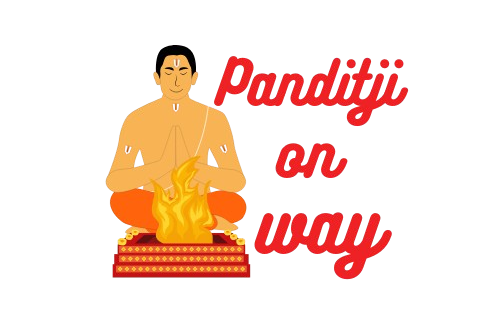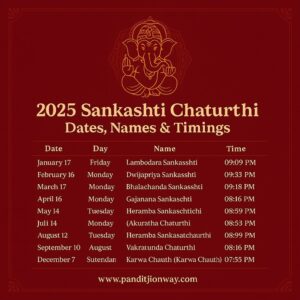Understanding Hindu Traditions: The 16 Sanskaras in Hinduism
16 Sanskaras in Hinduism: Hinduism, one of the most ancient spiritual traditions in the world, is deeply rooted in rituals that guide the soul through different stages of life. Among its most revered traditions are the 16 Samskaras, or rites of passage. These sacred rituals mark the journey of an individual from conception to death, helping purify and sanctify key moments in life.
For those looking to perform these Samskaras with experienced Vedic Pandits, Panditji On Way offers customized ritual services across India.
What Are Sanskaras in Hinduism?
The word Samskara is derived from Sanskrit roots: “Sam” meaning ‘well’ and “Kara” meaning ‘action’ — implying refinement or purification. Samskaras are ceremonies that purify the soul and prepare the mind and body for spiritual evolution.
Importance of Samskaras
- Spiritual Purification – Elevates the soul at each life stage
- Cultural Continuity – Preserves the ancient Vedic lifestyle
- Moral Foundation – Instills discipline, ethics, and purpose
- Social Unity – Strengthens familial and communal relationships
These rites are codified in ancient texts like the Grihya Sutras, Manusmriti, and the Dharmashastras.
List of 16 Sanskaras with Meaning and Rituals
1. Garbhadhana – Conception Ceremony
- Purpose: Bless the couple with a virtuous child
- When: Before conception
- Rituals: Vedic mantras are chanted to sanctify the union
2. Pumsavana – Fetal Well-being Ritual
- Purpose: Ensures the fetus’s health and traditionally, a male child
- When: Third month of pregnancy
- Rituals: Sacred herbs administered, mantras chanted by the father
3. Simantonayana – Baby Shower
- Purpose: Mental peace for the mother and protection of the unborn
- When: Between 4th and 7th month of pregnancy
- Rituals: Hair-parting ceremony, blessings, and Vedic chants
4. Jatakarma – Birth Ritual
- Purpose: Welcoming the newborn soul
- When: Immediately after birth
- Rituals: Sacred mantras whispered into the baby’s ear, honey & ghee administered
5. Namakarana – Naming Ceremony
- Purpose: Assigning an astrological name
- When: 11th or 12th day after birth
- Rituals: Naming done during puja and written on grains
6. Nishkramana – First Outing
- Purpose: Introducing the child to the outer world
- When: 4th month
- Rituals: Baby taken out under sunlight or moonlight
7. Annaprashana – First Feeding
- Purpose: Transition to solid food
- When: 6th month
- Rituals: Feeding of kheer, along with Vedic mantras
8. Chudakarana – Mundan Ceremony
- Purpose: Purification and growth of wisdom
- When: 1st or 3rd year
- Rituals: Head shaving, saving a small tuft in some traditions
9. Karnavedha – Ear Piercing
- Purpose: Health benefits and cultural identity
- When: Between 6 months to 5 years
- Rituals: Piercing ears while reciting protective mantras
10. Vidyarambha – Initiation into Learning
- Purpose: Beginning of formal education
- When: Around 5 years
- Rituals: Writing first letters (“ॐ”) in rice or sand
11. Upanayana – Sacred Thread Ceremony
- Purpose: Spiritual rebirth for study of Vedas
- When: 8–16 years (boys; now girls in some reform traditions)
- Rituals: Wearing Yajnopavita and Gayatri Mantra initiation
12. Vedarambha – Vedic Study
- Purpose: Commencing Vedic learning
- Rituals: Guru initiates the student into scriptural studies
13. Keshanta – First Beard Shaving
- Purpose: Marks transition to adulthood
- When: Around 16 years
- Rituals: Facial shaving and offering hair to sacred fire
14. Samavartana – Convocation Ceremony
- Purpose: Conclusion of student life (Brahmacharya)
- Rituals: Ceremonial bath, offering Guru Dakshina
15. Vivaha – Hindu Marriage
- Purpose: Entry into Grihastha Ashram (householder life)
- Rituals: Kanyadaan, Mangal Phera, Saptapadi
For Vedic marriage ceremonies, visit:
🔗 Book Pandit for Hindu Wedding
16. Antyeshti – Last Rites
- Purpose: Liberation of the soul (Atma Moksha)
- Rituals: Cremation, Pind Daan, and Shraddha rituals
Relevance of Sanskaras in Modern Hindu Life
Even today, these Samskaras:
- Promote moral values
- Preserve Sanatana Dharma traditions
- Provide emotional and spiritual support
- Bridge generations with shared cultural practices
Many families now opt for online Pandit booking for performing these rituals authentically with proper Vedic vidhi.
Visit: Book Pandit Online
Frequently Asked Questions (FAQs) about 16 Sanskaras in Hinduism
1. What are the 16 Sanskaras in Hinduism?
The 16 Sanskaras are sacred Hindu rites of passage that mark significant milestones in a person’s life—from conception to death. These rituals include Garbhadhana (conception), Jatakarma (birth), Upanayana (initiation), Vivaha (marriage), and Antyeshti (last rites), among others.
2. Why are Sanskaras important in Hindu dharma?
Samskaras play a vital role in refining the body, mind, and soul. They ensure spiritual progression, preserve Sanatan Dharma traditions, and promote discipline and social harmony. They are mentioned in scriptures like the Grihya Sutras and Manusmriti.
3. How many Sanskaras are practiced today in modern Hindu families?
While 16 Samskaras are prescribed, typically 5–8 are commonly practiced today—such as Namkaran, Annaprashan, Mundan, Upanayana, Vivaha, and Antyeshti—depending on the family tradition and region.
4. Is there any scientific or psychological benefit of performing Sanskaras?
Yes. Many Samskaras such as Annaprashana (first food), Karnavedha (ear piercing), and Vidyarambha (beginning education) have proven psychological and Ayurvedic relevance, aiding in healthy development and instilling life values early on.
5. Are the 16 Sanskaras gender-specific?
Traditionally, some Samskaras like Upanayana were performed only for boys. However, many modern families now follow gender-neutral Sanskara practices, especially for educational and spiritual milestones.
6. Can I book a Pandit for performing Samskaras online?
Yes, you can book certified Pandits for all 16 Samskaras across India through PanditJiOnWay.com – a trusted platform that offers verified purohits, proper ritual samagri, and customizable puja packages.
7. What is the significance of the Vivaha Samskara in Hindu marriage?
Vivaha Samskara is one of the most sacred rituals, signifying the union of two souls. It involves key elements like Saptapadi (seven steps) around the sacred fire, symbolizing mutual vows of duty, fidelity, and prosperity.
8. How do Samskaras help in leading a Dharmic life?
By following Samskaras, an individual aligns with Dharma (righteous living). They offer moral and spiritual guidance throughout life stages and help one attain Moksha (liberation) through gradual inner purification.
9. What scriptures mention the 16 Sanskaras?
The primary sources are the Vedas, Grihya Sutras, Manusmriti, and Smritis. These texts detail the ritualistic steps, mantras, and purpose behind each Samskara.
10. How are Samskaras different from other Hindu rituals like Pujas or Yajnas?
Samskaras are personal life-cycle rituals, while Pujas or Yajnas are offerings made to deities for specific desires or devotion. Samskaras are mandatory spiritual transformations; Pujas can be optional or occasion-based.
Conclusion
The 16 Sanskaras are not just age-old customs but timeless frameworks that guide a person spiritually, emotionally, and socially. From conception to the last rites, they define a life aligned with Dharma (righteousness).
To keep these traditions alive in the digital age, one can embrace authentic yet accessible ritual services through platforms like Panditji On Way.
Want to Perform Any of These Sanskaras?
Get Vedic experts for your family’s sacred rites today.
👉 Visit: Book Your Puja Now



